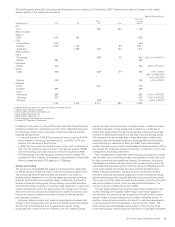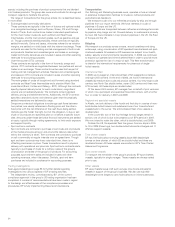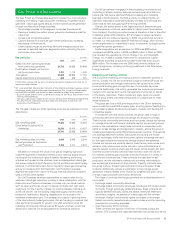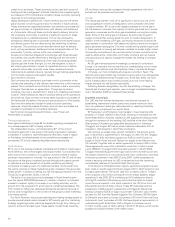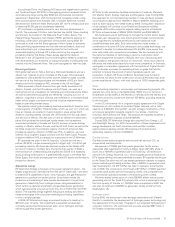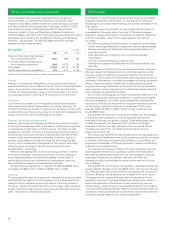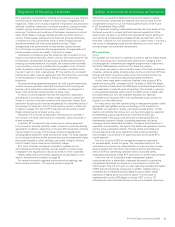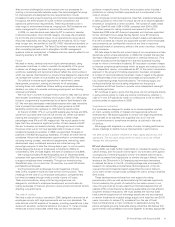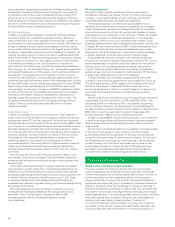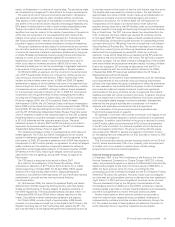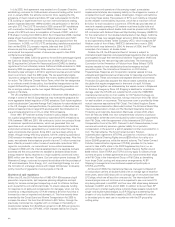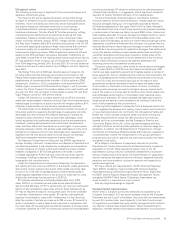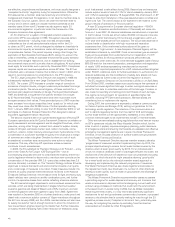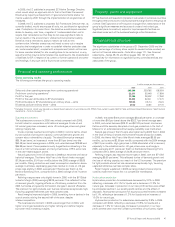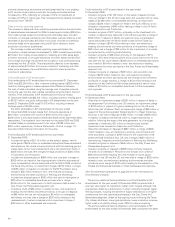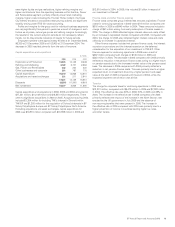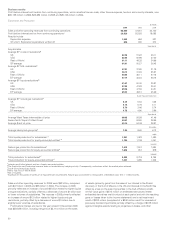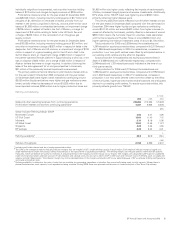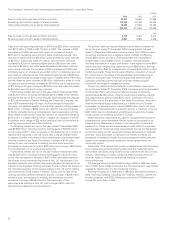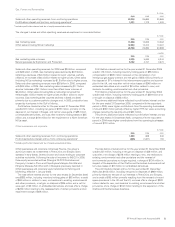BP 2006 Annual Report Download - page 45
Download and view the complete annual report
Please find page 45 of the 2006 BP annual report below. You can navigate through the pages in the report by either clicking on the pages listed below, or by using the keyword search tool below to find specific information within the annual report.earlier, on divestment or on closure of inactive sites. The provisions made
are considered by management to be sufficient for known requirements.
The extent and cost of future environmental restoration, remediation
and abatement programmes are often inherently difficult to estimate.
They depend on the magnitude of any possible contamination, the timing
and extent of the corrective actions required, technological feasibility and
BP’s share of liability relative to that of other solvent responsible parties.
Though the costs of future restoration and remediation could be
significant and may be material to the results of operations in the period in
which they are recognized, it is not expected that such costs will be
material to the group’s overall results of operations or financial position.
See Financial statements – Note 40 on page 152 for the amounts
provided in respect of environmental remediation and decommissioning.
The group’s operations are also subject to environmental and common
law claims for personal injury and property damage caused by the release
of chemicals, hazardous materials or petroleum substances by the group
or others. Nineteen proceedings involving governmental authorities are
pending or known to be contemplated against BP and certain of its
subsidiaries under federal, state or local environmental laws, each of
which could result in monetary sanctions of $100,000 or more. No
individual proceeding is, nor are the proceedings in aggregate, expected
to be material to the group’s results of operations or financial position.
On 23 March 2005, an explosion and fire occurred in the isomerization
unit of BP Products North America Inc.’s Texas City refinery as the unit
was coming out of planned maintenance. Fifteen workers died in the
incident and many others were injured. In 2005 and 2006, BP agreed
settlements in respect of all the fatalities and many of the personal injury
claims arising from the incident. Trials have been scheduled for a number
of unresolved claims in mid-2007, although to date all claims scheduled
for trial have been resolved in advance of trial. In 2006, BP continued its
co-operation with the governmental entities investigating the incident,
including the US Department of Justice (DOJ), the US Environmental
Protection Agency (EPA), the US Occupational Safety & Health
Administration (OSHA), the US Chemical Safety and Hazard Investigation
Board (CSB) and the Texas Commission on Environmental Quality (TCEQ).
During 2006, BP also devoted significant time and effort to co-operate
with the BP US Refineries Independent Safety Review Panel (the panel),
which it chartered in 2005 on the recommendation of the CSB to assess
the effectiveness of corporate oversight of safety management systems
at BP’s US refineries and the corporate safety culture. The panel
published its report in January 2007 and BP has publicly committed to
implement its recommendations (see Report of the BP US Refineries
Independent Safety Review Panel on page 29).
The incident prompted a number of investigations by other state and
federal agencies. The TCEQ and OSHA investigations of the incident
resulted in settlement agreements between BP and the agencies. In the
third quarter of 2005, BP reached a settlement with OSHA that resulted in
the payment of a $21.4 million penalty, an agreement to correct all alleged
safety violations and the retention of experts to assess the refinery’s
organization and process safety systems. In the second quarter of 2006,
BP settled with the TCEQ, resolving 27 alleged violations by paying
a $0.3 million fine and agreeing, among other things, to upgrade its
flare system.
The CSB report is expected to be issued in March 2007.
As a result of its investigation of the Texas City refinery, OSHA
conducted an inspection of BP Products North America Inc.’s Toledo
refinery beginning in October 2005. On 24 April 2006, OSHA issued
citations with a total penalty of $2.4 million, alleging 39 separate
violations of two different OSHA standards. BP and OSHA have reached
a settlement in principle and are working towards finalizing
the documentation.
On 15 November 2006, the Indiana Occupational Safety and Health
Administration (IOSHA) issued the Whiting refinery with three Safety
Orders and Notifications of Penalty alleging 14 separate violations of
the OSHA regulations. The total proposed penalty was $0.4 million. On
7 December 2006, BP and IOSHA met to discuss resolution of the
matter. Discussions to reach a settlement agreement are ongoing.
On 2 March 2006, a crude oil spill of approximately 4,800 barrels
occurred on a low-pressure transit line on the Alaskan North Slope in the
Western Operating Area of the Prudhoe Bay field operated by BP. The
spill was reported to all the appropriate government agencies as soon as
it was discovered and the portion of the line with the leak was shut down.
The pipeline leak was caused by internal corrosion. The spill affected
approximately two acres of frozen tundra. Clean-up and rehabilitation of
the area are complete and environmental damage to the tundra is
expected to be minimal. On 15 March 2006, the US Department of
Transportation (DOT) issued a Corrective Action Order (CAO) that
required, among other items, that BP develop a plan to run maintenance
pipeline inspection tools (pigs) and smart pigs through the three Prudhoe
Bay oil transit lines. The DOT has since issued two amendments to the
CAO. Combined, the three orders have required 34 corrective actions.
On 6 August 2006, BP Exploration Alaska ordered a phased shutdown of
the Prudhoe Bay oil field following the discovery of unexpectedly severe
corrosion and a spill of 199 barrels from the oil transit line in the Eastern
Operating Area of Prudhoe Bay. The decision was based on the receipt
of data from a smart pig run and follow-up inspections where corrosion-
related wall thinning appeared to exceed BP criteria for continued
operation. It was during these follow-up inspections that BP personnel
discovered a leak and a small spill to the tundra. The spill was contained
and clean-up began. US and State of Alaska investigations of the incident
have been initiated and subpoenas have been issued, including a Federal
Grand Jury subpoena. BP continues its discussions with the DOT to
assure compliance with the corrective actions outlined in the CADs.
In September 2006, BP executives testified before the US House of
Representatives and the US Senate.
Management cannot predict future developments, such as increasingly
strict requirements of environmental laws and resulting enforcement
policies, that might affect the group’s operations or affect the exploration
for new reserves or the products sold by the group. A risk of increased
environmental costs and impacts is inherent in particular operations
and products of the group and there can be no assurance that material
liabilities and costs will not be incurred in the future. In general, the group
does not expect that it will be affected differently from other companies
with comparable assets engaged in similar businesses. Management
believes that the group’s activities are in compliance in all material
respects with applicable environmental laws and regulations.
For a discussion of the group’s environmental expenditure see
Environmental expenditure on page 54.
BP operates in more than 100 countries worldwide. In all regions of the
world, BP has processes designed to ensure compliance with applicable
regulations. In addition, each individual in the group is required to comply
with BP health, safety and environmental (HSE) policies as embedded
in the BP code of conduct. Our partners, suppliers and contractors are
also encouraged to adopt them. The group is working with the equity-
accounted entity TNK-BP to develop management information to allow
for the assessment and measurement of their activities in relation to HSE
regulations and obligations.
This Environmental protection section focuses primarily on the US and
the EU, where approximately 70% of our property, plant and equipment
is located, and on two issues of a global nature: climate change
programmes and maritime oil spills regulations.
Climate change programmes
In December 1997, at the Third Conference of the Parties to the United
Nations Framework Convention on Climate Change (UNFCCC) in Kyoto,
Japan, the participants agreed on a system of differentiated internationally
legally binding targets for the first commitment period of 2008-2012. In
2005, the Kyoto protocol came into force, committing the 156
participating countries to emissions targets and the EU Emissions Trading
Scheme (ETS) came into operation. However, Kyoto was only designed
as a first step and policymakers continue to discuss what new agreement
might follow it in 2012 and how all significant countries can be involved.
This was discussed further by the G8 group of world leaders at their
St Petersburg summit in 2006 and at the UNFCC conference in Nairobi,
where progress was made on climate impacts adaptation and vulnerability
and there was agreement to review the Kyoto protocol by 2008.
Market mechanisms to allow optimum utilization of resources to
meet the national Kyoto targets are being considered, developed or
implemented by individual countries and also internationally through the
EU. The relative success of these systems will determine the extent to
which alternative fiscal or regulatory measures may be applied.
BP Annual Report and Accounts 2006 43


